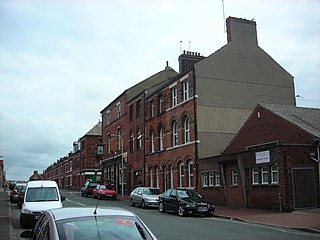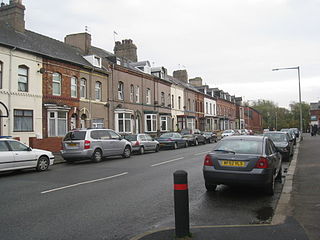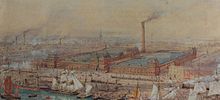
Barrow-in-Furness is a port town and civil parish in the Westmorland and Furness district, in the ceremonial county of Cumbria, England. Historically in Lancashire, it was incorporated as a municipal borough in 1867 and merged with Dalton-in-Furness Urban District in 1974 to form the Borough of Barrow-in-Furness. In 2023, the borough merged with Eden and South Lakeland districts to form a new unitary authority: Westmorland and Furness. At the tip of the Furness peninsula, close to the Lake District, it is bordered by Morecambe Bay, the Duddon Estuary and the Irish Sea. In 2021, Barrow's population was 55,489, making it the second largest urban area in Cumbria after Carlisle, and the largest in the Westmorland and Furness unitary authority.

The Furness Railway (Furness) was a railway company operating in the Furness area of Lancashire in North West England.

Vulcan Iron Works was the name of several iron foundries in both England and the United States during the Industrial Revolution and, in one case, lasting until the mid-20th century. Vulcan, the Roman god of fire and smithery, was a popular namesake for these foundries.

Barrow Island is an area and electoral ward of Barrow-in-Furness, Cumbria, England. Originally separate from the British mainland, land reclamation in the 1860s saw the northern fringes of the island connected to Central Barrow. Barrow Island is also bound to the south and east by the town's dock system and to the west by Walney Channel. The Ward population taken at the 2011 census was 2,616.
The jute trade is centered mainly around India's West Bengal and Assam, and Bangladesh. The major producing country of jute is India and biggest exporter is Bangladesh, due to their natural fertile soil. Production of jute by India and Bangladesh are respectively 1.968 million ton and 1.349 million metric ton. Bengal jute was exported to South East Asia from the 17th century by the Dutch, French and later by other Europeans.

Titagarh is a city and a municipality of North 24 Parganas district in the Indian state of West Bengal. It is close to Kolkata and also a part of the area covered by Kolkata Metropolitan Development Authority (KMDA).
Dundee is the fourth-largest city in Scotland with a population of around 150,000 people. It is situated on the north bank of the Firth of Tay on the east coast of the Central Lowlands of Scotland. The Dundee area has been settled since the Mesolithic with evidence of Pictish habitation beginning in the Iron Age. During the Medieval Era the city became a prominent trading port and was the site of many battles. Throughout the Industrial Revolution, the local jute industry caused the city to grow rapidly. In this period, Dundee also gained prominence due to its marmalade industry and its journalism, giving Dundee its epithet as the city of "jute, jam and journalism".

Hindpool is an area and electoral ward of Barrow-in-Furness, Cumbria, England. It is bordered by Barrow Island, Central Barrow, Ormsgill, Parkside and the Walney Channel, the local population stood at 5,851 in 2011. The ward covers the entire western half of the town centre and includes Barrow's main shopping district. Other local landmarks include the Furness College Channelside campus, the Dock Museum and the Main Public Library. Hindpool is also home to two stadia - Barrow Raiders' Craven Park and Barrow A.F.C.'s Holker Street.

Abbey Road is the principal north to south arterial road through Barrow-in-Furness, Cumbria, England.

The Port of Barrow refers to the enclosed dock system within the town of Barrow-in-Furness, England. Morecambe Bay is to the east of the port and the Irish Sea surrounds it to the south and west. The port is currently owned and operated by Associated British Ports Holdings, but some land is shared with BAE Systems Submarine Solutions. Currently consisting of four large docks, the Port of Barrow is one of North West England's most important ports. The docks are as follows: Buccleuch Dock, Cavendish Dock, Devonshire Dock and Ramsden Dock. The port of Barrow is the only deep water port between the Mersey and the Clyde.

Parkside is an area and electoral ward of Barrow-in-Furness, Cumbria, England. It is bordered by Hindpool, Ormsgill, Hawcoat, Newbarns and Risedale and had a population of 5,742 in 2001, reducing to 5,584 at the 2011 Census. It is one of the town's most centralised wards and contains Barrow's main park, as well as the newly established Furness Academy.

The Hindpool Retail Parks are a set of four conjoined retail parks in the Hindpool area of Barrow-in-Furness, England, United Kingdom. Some thirty stores and leisure facilities contain a total of 43,000 m2 (460,000 sq ft) of retail space. The four retail parks are Cornerhouse Retail Park, Cornmill Crossing, Hindpool Retail Park and Hollywood Park. The largest and only other retail park in Barrow is Walney Road Retail Park - Asda, Argos, Home Bargains, Matalan, Pound Stretcher, Starbucks and Stollers.

The Land Yeo is a small river which flows through North Somerset, England. It rises on Dundry Hill and supplies Barrow Gurney Reservoirs before flowing through various villages to Clevedon where it drains into the Severn Estuary. During the past 1,000 years it has powered at least ten watermills, however only one is still functional. Since 2003 initiatives have been undertaken to clean up the river, improving water quality and encouraging wildlife.

The Barrow Hematite Steel Company Limited was a major iron and steel producer based in Barrow-in-Furness, Lancashire, England, between 1859 and 1963. At the turn of the 20th century and the Technological Revolution it operated the largest steel mill in the world.

Camperdown Works was a jute works in Dundee, Scotland, which covered around 30 acres and at one point employed over 14,000, mostly female, workers. It was for a time the world's largest jute works and was owned by Cox Brothers.

The John Whinnerah Institute is a Grade II listed Art Deco building and former educational establishment located on Abbey Road in Barrow-in-Furness, England. Having been constructed between 1937 and 1938 on the site of the demolished Jute Works it is the newest listed structure in the town, despite this it was drastically altered in 2004 when the entire interior was demolished to accommodate new retail units leaving only the Abbey Road and Hindpool Road facades.

The Custom House in Barrow-in-Furness, Cumbria, England is a former government building, having housed the customs offices for trade handled at the Ports of Barrow and Lancaster. Initially constructed as a hotel around 1870, it took on its most notable role as a custom house in 1880, regulating custom from the Port of Lancaster.
The following is a timeline of the history of Barrow-in-Furness, England, United Kingdom.

Ramsden Square is a square located at the intersection of Abbey Road and Duke Street in Barrow-in-Furness, Cumbria, England. It marks the boundary of the Central and Hindpool wards and now acts as a major roundabout. Ramsden Square was first laid out in the 1840s to act as a focal point of Sir James Ramsden's master plan for the new town of Barrow, separating its burgeoning industries and commercial core. The centerpiece of the square is a statue of Ramsden himself while it is framed by a number of historic buildings including Barrow Central Library, the National Westminster Bank Building and formerly the Barrow Jute Works.
The Acland Mill was the first jute mill established in India. The mill was established in 1855 by British entrepreneur George Acland and Bengali financier Babu Bysumber Sen in Rishra, Bengal Presidency, British India.

















